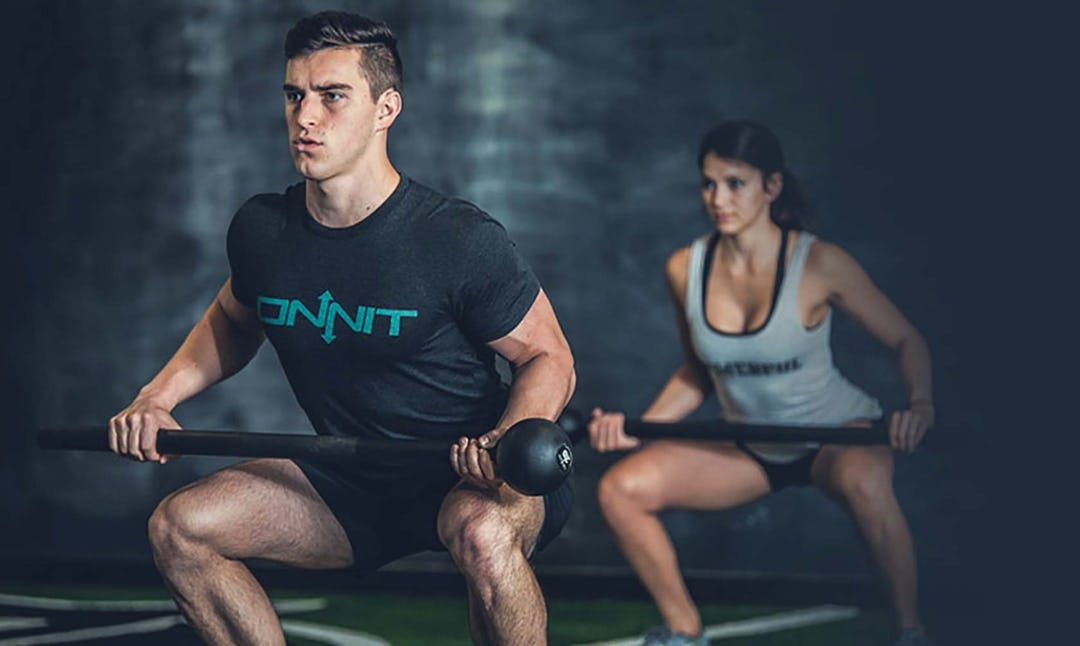The Steel Mace has quickly become one of my favorite tools to work with. I had played around with the Steel Mace for some time, but since becoming a Steel Mace Specialist through ONNIT Academy, I’ve been honing and refining my skills with this tool in new ways.
I’ve been toying with concepts and ideas that have helped me learn more about myself (strengths and weaknesses) as well as about my clients. As I’ve programmed for individuals and groups, I’ve zeroed in on a few ways in which to engage my clients with the Steel Mace (both as individuals and in a group setting).
I recently had a conversation with a colleague about this topic and as I was sharing with him my ideas on programming, I realized that these concepts would be helpful to any Steel Mace Specialist or even enthusiast working out on their own.
Although I’m sure there are plenty of ways to program a Steel Mace class, I’ve come up with three basic focal points for my Steel Mace Training programs, based on concepts from my experience as a Salsa dancer. They are:
1. Skill Acquisition
2. Foundational Movement Centered
3. Choreography Style
When I lived in Bangkok, I was looking for something constructive to do with my evenings and a guy who lived next door to me told me about a Salsa club where I could learn to dance before the party started. I checked it and after my first class I was hooked.
I returned every Thursday night for the class and party. The class was a step by step training, which started with basic steps and finished with a few moves put together in sequence. We then practiced a few times to music and once the party started, I used the hell out of those moves until they became second nature, assessing whether my hands in the right place? Were my steps correct?
Each week I built on the last week’s knowledge and each party I added new moves to my repertoire. I learned to sequence moves together until they became a “flow” and I could complete a 4 minute song with variety. Before I knew it, I went from the guy no one wanted to dance with to the guy every woman wanted to dance with. My dancing became unconscious, effortless and smooth.
See where we’re heading here?
My 3 Styles of Steel Mace Training Programs are based on these concepts:

1. Skill Acquisition
This format is based on acquiring a specific skill. So in Salsa I would liken this to learning to Hook Turn, Spin or a Cross Body Lead. There are specific steps involved. The steps would be demonstrated and then we would work and drill that specific movement.
For a Steel Mace Training Program, we may choose to introduce two or three basic movements in the training session. Lets take the Lap Squat with Handswitch for example. I would teach this movement in steps and create mini intervals to refine those skills just learned.
Assume everyone is a beginner and even if they’ve attended your class previously, it doesn’t hurt to refresh them on their landmarks.
Sample 1 Exercise Program:
Part 1
• Holding the Steel Mace properly (over under, pulling the scapulae down and back, creating weight where there’s no weight) – all concepts a Specialist would know.
• 30 to 45 second engaged holds with the Steel Mace Head on each side, 15 second rest x4 total Rounds (total time: 3 to 4 mins)
Part 2
• Lap Squat – teach the Lap Squat
• 2 sets 45:15 second work:rest ratio. (total time: 4mins)
Part 3
• Hand Switch Instruction (Middle to Prayer, Pet the Cat and Middle) – Go through it slowly together.
• 2 sets 30:15 second work:rest ratio. (total time: 90 seconds)
Part 4: Combine Squat & Switches
• 2 Rounds 45:15 work:rest ratio (total time: 90 seconds)
Total time for 1 Exercise Skill Acquisition: 10 to 11mins working time. 15 minutes when instruction, demonstration time is included.
2. Foundational Movement Centered
This format is centered on the concept of the four Foundational movements; Squat, Hinge, Push, Pull. It’s more geared towards improving strength.
I would compare this to learning the basic steps in Salsa and learning the beat counts. These things are at the core of anything and everything you do.
Choose a Foundational Movement like the Pull for example. Design your program by choosing a few Pull Movements.
I like to work these movements with a focus on the start and endpoint of the movements or Landmarks. Holding at one end of the movement before moving to the other end of the movement.
Example: High Hinge Row
Step 1: Cue correct start position of high hinge position while holding the mace; Shoulders engage with Scapulas down and back; Pulling apart on the mace.
Step 2: Have clients move slowly to pull the Steel Mace towards the Belly Button.
*Note: I like to either do the exercise with the client(s) or count out loud the speed I’d like them to move with.
Step 3: Hold at this position for a 5 count before lowering
Step 4: Make sure to cue re-engagement of the Scapulae before the second rep.
Protocol: 5 Sets of 5 Reps: 60 second Rest per set
3. Choreography Style
Finally, we have Choreography Style. This style is best utilized when teaching a flow.
You can demonstrate the flow at the start if you choose to. I prefer not to do this, but to start by instructing the first exercise after warmups and movement prep.
Here’s the outline for the workout:
Part A: Lap Squat Instruction
A1: Lap Squat Practice x 30 sec
Rest: 15 sec x 3 sets
Total Time: 2:15 mins
Part B: Prayer Handswitch & Switch Squat Instruction
B1: Switch Squat Practice x 30 sec
Rest: 15 sec x 2 sets
Total Time: 1:30 mins
Part C: Cross Body Top Position & Extended Shoulder Curl Instruction
C1: Extended Shoulder Curl Practice x 30 sec
Rest: 15 sec x 2 sets
Total Time: 1:30 mins
Part D: Extended Shoulder Curl with Prayer Switch
D1: Practice x 30 sec
Rest: 15 sec x 2 sets
Total Time: 1:30 mins
Part E: Lap Side Lunge Instruction
E1: Lap Side Lunge Practice x 30 sec
Rest: 15 sec x 2 sets
Total Time: 1:30 mins
Part F: Lap Side Lunge with Prayer Switch
F1: Practice x 30 sec
Rest: 15 sec x 2 sets
Total Time: 1:30 mins
Part G:Shaolin Archer Flow
Perform one repetition of each, one after the other with no rest. Continue for allotted time.
Total Time: 10 mins

)





